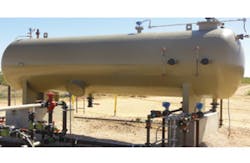What is Solids Separation Process Controls in Primary Wastewater Treatment?
Solids — including those suspended, settle-able and floatable — are non-liquid or fluid substances that are separated from clarified wastewater in primary treatment.
Suspended solids are defined as small solid particles that remain in suspension in water as a colloid, or due to the motion of the water. Settle-able solids are particles that will settle within a reasonable length of time when there is very little movement. The weight by volume of settle-able solids is greater than water. Floatable solids float because their weight by volume of floatable solids is less than water.
Primary wastewater treatment processes that remove these solids in process containers include primary clarifiers, air flotation units and cone shape imhoff settlers. While effective solids separation supersedes controls on pH, flow and other factors, general process controls for operating each of the process containers are below:
Primary clarifiers
The most important function of the primary clarifier is to remove as much settle-able and suspended material as possible. Removal of organic settle-able solids is important because they cause a high demand for oxygen (BOD) in subsequent biological treatment units in the treatment plant or receiving waters.
Many factors influence settling characteristics in a particular clarifier. A few of the more common ones are temperature, short circuits, detention time, weir overflow rate, surface loading rate, and solids loading. Three of these factors are discussed below.
1. Temperature: In general, as water temperature increases, the settling rate of particles increases; as temperature decreases, so does the settling rate.
2. Short circuits: As wastewater enters the settling tank, it should be evenly dispersed through the entire cross-section of the tank. It should flow at the same velocity in all areas toward the discharge end. If velocity is greater in some sections than others, short-circuiting may occur.
Short-circuiting also may be caused by turbulence and stratification of density layers due to temperature or salinity. Temperature layers can cause short-circuiting.
3. Detention Time: Wastewater should remain in the clarifier long enough to allow sufficient settling time for solid particles. If the tank is too small for the quantity of flow and the settling rate of the particles, too many particles will be carried out the effluent of the clarifier.
Air flotation units
The objective of flotation thickening is to separate solids from the liquid phase by matching air bubbles to particles of suspended solids. Four general methods of flotation are commonly used as follows:
1. Dispersed air flotation where bubbles are generated by mixers or diffused aerators.
2. Biological flotation where gases formed by biological activity are used to float solids.
3. Dissolved air, vacuum flotation where water is aerated at atmospheric pressure and released under a vacuum.
4. Dissolved air, pressure flotation where air is put into solution under pressure and released at atmospheric pressure.
The performance of dissolved air flotation units depends on; type of sludge, age of the feed sludge, solids and hydraulic loadings, air to solids (A/S) ratio, recycle rate, and sludge blanker depth.
Operational guidelines are affected by the size of dissolved air flotation units.
The operation performance can be optimized by controlling Air/Solids (A/S) ratio, recycle rate, and the blanket thickness by properly adjusting these variables. These control variables are affected by solids and hydraulic loading rates. Controls should be established to prevent solids or hydraulic loading to become excessive, which would cause effluent quality to decline and reduce thickened sludge concentrations.
Operation performance is optimized by conditions below:
Air-to-solids ratio: The optimum ratio should be established and maintained. It is affected by the quantity of air introduced and dissolved into the recycle or waste-stream, which is in turn critical in the operation of flotation thickeners. Enough air has to be added and dissolved to float the sludge solids. The most effective method of accomplishing this is to introduce air into a pressurized retention tank along with the waste-stream to be thickened or along with a portion of the thickener effluent stream. Air also can be dissolved in primary or secondary effluent, thus avoiding solids recycling in the dissolved air flotation (DAF) unit. Mixing of the retention tank contents should also be used to increase the amount of air that can be put into solution.
Recycle rate and sludge blanket: Both the rate of effluent recycle and the thickness of the sludge blanket are operational controls available to optimize Dissolved Air Flotation (DAF) performance.
Note on Imhoff tanks
Imhoff tanks are rarely constructed today. Your plant may incorporate an Imhoff tank only if was constructed many years ago, perhaps in the 1980s. Cone shape Imhoff settler tanks are unique because the Imhoff tank combines sedimentation and sludge digestion in the same process unit.
The majority of primary industrial wastewater-treatment solids-separation process units operate with clarifiers and flotation devices which are covered in this article.
Certain general steps separating solids during primary wastewater treatment have been described above, however if you have specific solids separation or other wastewater queries, please submit a question.
